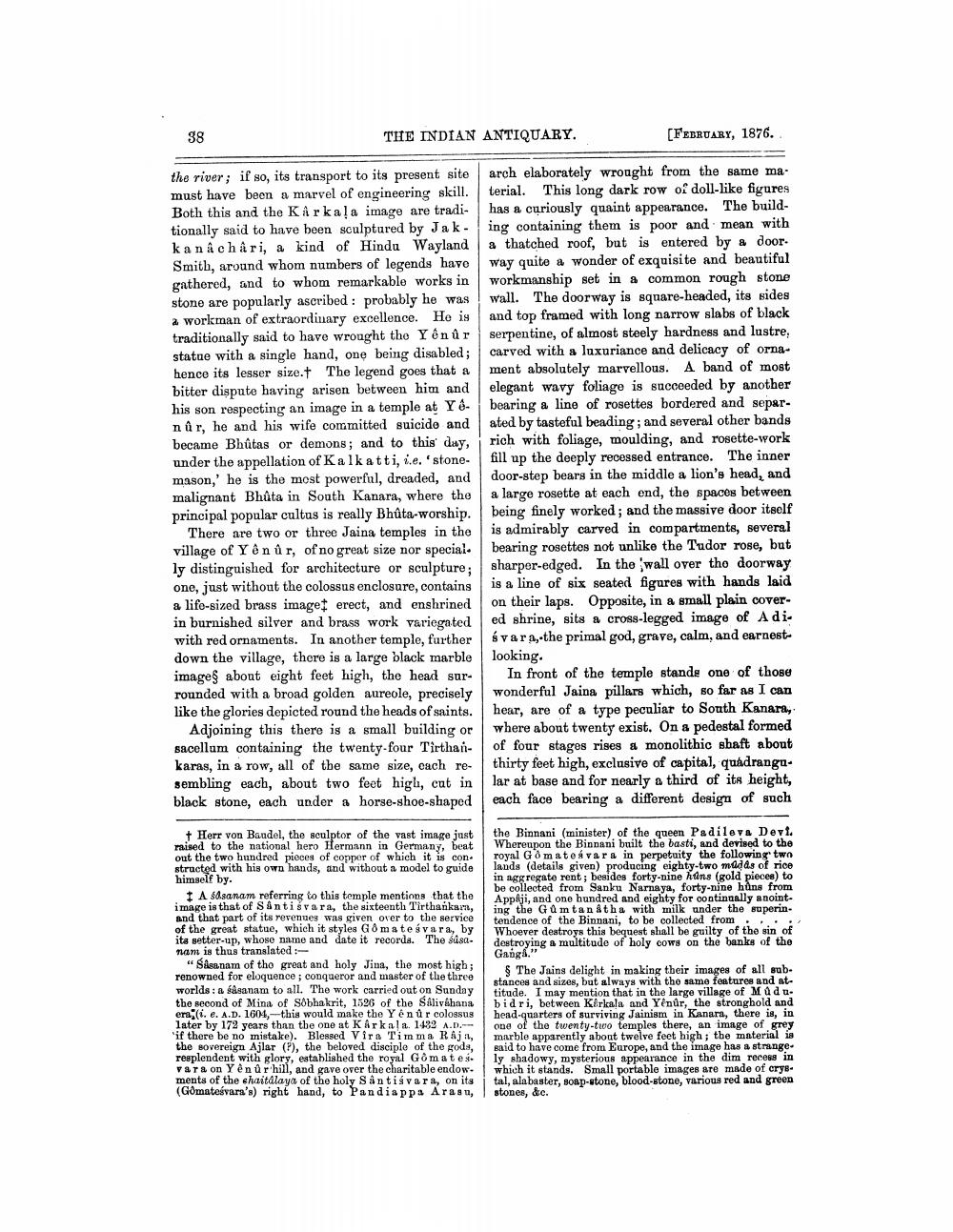________________
38
THE INDIAN ANTIQUARY.
(FEBRUARY, 1876.
the river; if so, its transport to its present site must have been a marvel of engineering skill. Both this and the Karkala image are traditionally said to have been sculptured by Jak ka na chari, a kind of Hindu Wayland Smith, around whom numbers of legends have gathered, and to whom remarkable works in stone are popularly ascribed : probably he was a workman of extraordinary excellence. Ho is traditionally said to have wrought the Yonar statue with a single hand, one being disabled; hence its lesser size. The legend goes that a bitter dispute having arisen between him and his son respecting an image in a temple at Y8. nûr, he and his wife committed suicide and became Bhůtas or demons; and to this day, under the appellation of Kalkatti, i.e.'stonemason,' he is the most powerful, dreaded, and malignant Bhůta in South Kanara, where the principal popular cultus is really Bhuta-worship.
There are two or three Jaina temples in the village of Yên ûr, of no great size nor special ly distinguished for architecture or sculpture; one, just without the colossus enclosure, contains a life-sized brass imaget erect, and enshrined in burnished silver and brass work variegated with red ornaments. In another temple, further down the village, there is a large black marble images about eight feet high, the head surrounded with a broad golden aureole, precisely like the glories depicted round the heads of saints.
Adjoining this there is a small building or sacellum containing the twenty-four Tirthankaras, in a row, all of the same size, cach resembling each, about two feet higli, cut in black stone, each under a horse-shoe-shaped
arch elaborately wrought from the same material. This long dark row of doll-like figures has a curiously quaint appearance. The building containing them is poor and mean with a thatched roof, but is entered by a door. way quite a wonder of exquisite and beautiful workmanship set in a common rough stone wall. The doorway is square-headed, its sides and top framed with long narrow slabs of black serpentine, of almost steely hardness and lustre, carved with a luxuriance and delicacy of orna. ment absolutely marvellous. A band of most elegant wavy foliage is succeeded by another bearing a line of rosettes bordered and separ. ated by tasteful beading; and several other bands rich with foliage, moulding, and rosette-work fill up the deeply recessed entrance. The inner door-step bears in the middle a lion's head, and a large rosette at each end, the spaces between being finely worked; and the massive door itself is admirably carved in compartments, several bearing rosettes not unlike the Tudor rose, but sharper-edged. In the wall over tho doorway is a line of six seated figures with hands laid on their laps. Opposite, in a small plain covered shrine, sits a cross-legged image of Adi. svara, the primal god, grave, calm, and earnestlooking.
In front of the temple stande one of those wonderful Jaina pillars which, so far as I can hear, are of a type peculiar to South Kanara, where about twenty exist. On & pedestal formed of four stages rises a monolithic shaft about thirty feet high, exclusive of capital, quadrangu. lar at base and for nearly a third of its height, each face bearing a different design of such
+ Herr von Bandel, the sculptor of the vast image just the Binnani (minister) of the queen Padileva Devi raised to the national hero Hermann in Germany, beat
Whereupon the Binnani built the basti, and devised to the out the two hundred pieces of copper of which it is con- royal Gomatesvara in perpetuity the following two structed with his own hands, and without a model to guide
lands (details given) producing eighty-two modes of rice himself by.
in aggregate rent; besides forty-nine hans (gold pieces) to
be collected from Sanku Narnaya, forty-nine hans from 1 A &dsanam referring to this temple mentions that the
Applji, and one hundred and eighty for continually anoint. image is that of Santišvara, the sixteenth Tirthakam,
ing the Gamtan atha with milk under the superin. and that part of its revenues was given over to the service
tendence of the Binnani, to be collected from . . . . of the great statue, which it styles Gomatesvara, by
Whoever destroys this bequest shall be guilty of the sin of ita setter-up, whose name and date it records. The sasa
destroying a multitude of holy cows on the banks of the nam is thus translated :
Ganga." "Sasanam of the great and holy Jina, the most high; renowned for eloquence; conqueror and master of the three
The Jains delight in making their images of all sub.
stances and sizes, but always with the same features and at. worlds: Sanam to all. The work carried out on Sunday
titude. I may mention that in the large village of Mud u. the second of Mina of sábhakrit, 1696 of the Salivahanabidri. between Kirala and Yênûr. the stronghold and erai.. A.D. 1604, this would make the Yên Qr colossus head-quarters of surviving Jainism in Kanars, there is, in later by 179 years than the one at Karkala 1439 A.D. one of the twenty-treo temples there, an image of grey 'if there be no mistake). Blessed Vira Timma Raji, marble apparently about twelve feet high; the material is the sovereign Ajlar (?), the beloved disciple of the gods, said to have come from Europe, and the image has a strange resplendent with glory. established the royal Gomates. lv shadowy, mysterious appearance in the dim recess in VBTs on Y en rhill, and gave over the charitable endow. which it stands. Small portable images are made of crys. ments of the chaitalaya of the holy Santišvari, on its tal, alabaster, soap-stone, blood-stone, various red and green (Gomatesvara's) right hand, to Pandiappa Aran, stones, &c.




